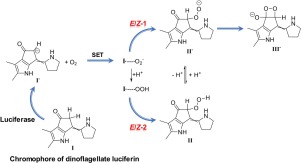Journal of Photochemistry and Photobiology A: Chemistry ( IF 4.3 ) Pub Date : 2020-03-18 , DOI: 10.1016/j.jphotochem.2020.112488 Ming-Yu Wang , Ya-Jun Liu

|
Dinoflagellates are worldwide distributed eukaryotic protists. Some species are capable of emitting blue light in response to fluid shear stress. Like most oxygen-dependent bioluminescent system, oxygenation of luciferin (LH2), forming high energy intermediate (HEI), is the initial step of dinoflagellate bioluminescence. This process is far from being totally understood due to the lack of both theoretical and experimental evidence. In the present paper, the detailed processes of the LH2 oxygenation reactions of dinoflagellate bioluminescence to produce two possible HEIs were investigated by density functional theory and multi-reference calculations. The single-electron transfer mechanism on the ground-state (S0) potential energy surface (PES) was proposed. This is different from the cases of firefly squid and bacteria bioluminescence, whose LH2 oxygenation occurs from the first triplet (T1) PES then the S0 PES via an intersystem crossing process. This paper aims to provide a theoretical basis to experimental research and help understand dinoflagellate bioluminescence.
中文翻译:

引发鞭毛生物发光的机理研究
鞭毛虫是全世界分布的真核生物。一些物种能够响应流体剪切应力而发出蓝光。像大多数依赖氧气的生物发光系统一样,形成高能中间体(HEI)的荧光素(LH 2)氧化是二鞭毛生物发光的第一步。由于缺乏理论和实验证据,因此尚未完全理解该过程。本文通过密度泛函理论和多参考计算研究了鞭毛生物发光的LH 2氧化反应产生两种可能的HEI的详细过程。基态上的单电子转移机制(S 0)提出了势能面(PES)。这与萤火虫鱿鱼和细菌生物发光的情况不同,后者的LH 2氧合通过系统间交叉过程从第一个三重态(T 1)PES到S 0 PES发生。本文旨在为实验研究提供理论依据,并有助于理解鞭毛生物发光。


























 京公网安备 11010802027423号
京公网安备 11010802027423号